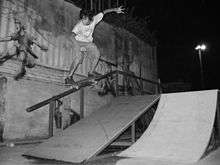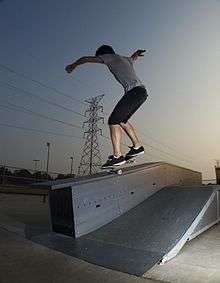Grind (skateboarding)
In skateboarding, Grinds are tricks that involve the skateboarder sliding along mainly relying on the use of the trucks of a skateboard. Grinds can be performed on any object narrow enough to fit between wheels and are often performed on the coping (edge) of a skate ramp, a purpose-built "funbox", step, ledge or horizontally-positioned pole.
Grinding is damaging to materials which are not hardened for the specific purpose of the sport, as may be found in a skate park. The trucks are composed of a hard metal without lubricant or bearings on the grinding surface, so they literally do grind on the objects they slide across. Grinding can strip paint off of steel and wear down the edges of concrete, stone, aluminum, and wood building materials. Affected business owners and government buildings have put up anti-skate devices as a deterrent to grinding.[1] Grinding in public places may be seen as a form of vandalism and may cause skateboarding to be banned by business owners and city ordinances.[2]
History
The move likely originated in backyard pools in the early 70's , as the early skaters gained in skill and confidence with their high speed carves around the top of the pool walls and one day went that little bit too high . The trucks of the time, often being merely 'borrowed' rollerskate trucks , didn't allow much contact due to their narrowness, but as skateboarding gained its own truck manufacturers who widened the hanger design, the possibilities for exploration became apparent, and all sorts of moves started popping up . There was a big leap in street skating starting in the 90's . It has evolved ever since. Today, grinds are commonly performed on handrails, lips of benches, tables, hubbas (ledge on a slope), on a hard normal ledge, a flatbar, or just simply anything that is possible enough to grind on it.
Back-side or front-side
Whether a grind is back-side (BS) or front-side (FS) depends on how rider approaches the rail or edge. If the skater approaches the rail with his back to it, the grind is a back-side grind. If the skater approaches the rail with the front of his body to the rail, the grind is a front-side grind.
List of grinds
- 50-50 Grind

- The 50-50 grind is where both trucks are on the edge. This move evolved from the horizontal-stance carve grind in pools and was taken up on top of the lip by such skaters as Jay Adams, Tony Alva and Stacy Peralta. Also called "Axelgrind".
Combo: Manny Santiago kickflip to bs 50-50.
- 5-0 Grind
- Pronounced "Five-Oh". In this maneuver, the back truck grinds the rail/edge, while the front truck is suspended directly above the rail/edge. This move is similar to the manual, although the tail may be scraped against the obstacle as well as the back truck, which is not considered proper on a manual.
- Nosegrind
- In a Nosegrind, the skateboard's front truck grinds a rail or edge, while the back truck is suspended over the rail/edge. It is similar to the nose manual, except performed on a rail, coping, or ledge. This move originated on vert, initially in the form of Neil Blender's New Deal (nose pivot to disaster), then by his more advanced progression of said move, the "Newer Deal", which left out the disaster part and just pivoted all the way back in.

- Crooked Grind
- Also known as Crooks, Crux, Pointer Grind, or the K-grind after the man to whom the trick is most commonly accredited, Eric Koston. It is like a nosegrind, but the tail of the board is angled away from the rail/ledge on which the trick is performed, causing the edge of the deck's nose to also rub. Invented by Eric Koston.
- Overcrook Grind
- Also known as Overcrooks, or Overcrux, is similar to the Crooked grind, but with the tail of the board being angled towards the far side of the rail/box.
- Feeble Grind
- In this move, the back truck grinds a rail while the front truck hangs over the rail's far side. Professional skateboarer Josh Nelson is the inventor of this grind back in 1986 at the Del Mar skate ranch in Del Mar, California. The name feeble grind came from Josh Nelson's friend and fellow skateboarder Sean Donnelley. Sean used to call Josh "the feeb" which was short for feeble, because Nelson was so skinny and often had broken limbs and injuries from skateboarding. Many people watched Josh create this unique type of grind on the parking blocks that were mounted in the reservoir at the Del Mar Skate Ranch.

- Smith Grind
- This maneuver entails the back truck grinding an edge or rail, while the front truck hangs over the near side of the object, leaving the edge of the deck to rub the lip/edge. This trick was named after its inventor Mike Smith (skateboarder). It is considered by many to be the most difficult basic grind trick. The backside version known as a Monty Grind was originated by Florida powerhouse Monty Nolder.
- Willy Grind
- Popularized by Willy Santos. Very rarely executed, the Willy is done with the front truck sliding on the grinding surface (as in a nose grind) while the back truck hangs down below the surface on the side to which the skateboarder approached. Also called "Lazy Grind", "Nosesmith", or "Scum Grind."
- Losi Grind
- Popularized by Allen Losi. Can be best described as an Overcrook with the tail hanging below a rail or with wheels sliding along on a ledge or as a Willy with the tail on the other side of the obstacle. Also called "Nosefeeble," "Over Willy Grind" or "Over-Scum."
- Suski Grind
- Popularized by Aaron Suski. This is also very similar to the 5-0 but unlike the salad grind your front trucks are pointed towards you like a smith grind but above the ledge unlike the smith grind. Simply a raised smith grind.
- Salad Grind
- A cross between a bluntslide and a 5-0, the front truck is suspended over the far side of the rail/edge the grind is performed on and pointed upwards to where the tail may even touch and slide on the side of the grinding surface. Like the "overcrook" grind is like a crooked nosegrind, the Salad grind is like a crooked 5-0, or a combo 5-0/bluntslide. This trick has been invented by Eric Dressen, hence the name (dressen, dressing, salad dressing). Simply a raised feeble.
- Hurricane Grind
- A 180 degree turn into a switch Over-Willy, exiting via a little less than 180 degree return spin. This trick was invented on vert by Neil Blender in 1985; an early proto-version can by witnessed in Powell Peralta's second video, Future Primitive, during Blender's brief cameo appearance on Lance Mountain's backyard ramp. Many of today's pros also do it on street obstacles such as handrails and ledges. This trick is easier to perform backside, but Tony Hawk did introduce the rarer frontside version in 1989.
- Sugarcane Grind
- This trick can be described as a 180 into switch Willy [3]
- Bennett Grind
- The same as the Hurricane and Sugarcane grinds, except instead of landing into a switch Over-Willy or Willy, land into a switch smith grind. Named after Matt Bennett.[4]
- Caveman Grinds
- A caveman grind is when a skater, instead of ollieing up onto a rail, starts with the board in his hand, places it onto the rail in the desired grind position and at the same time jumps onto the board, starting the grind.
- 5-0 Hand Drag
- This trick is a 5-0 and while doing one, you drag your back hand on the rail/ledge.
- Tractor Grind
- 5-0 Hand Drag with the front hand
- Nosegrind Hand Drag
- This trick is a nosegrind while you drag your back hand on the rail/ledge.
- Layback Grind
- This is a classic variation of the basic frontside or backside grind whereupon the skater leans back ("lays back") and places their trailing hand on or near the lip being ground, ostensibly to help "push" the grind further. Original Bones Brigade member Jay Smith did the earliest and most popular frontside examples, slashing out violently at the lip with his board while placing his hand well down the transition, in a very "surf-style" pose. By 1979 the move was being taken up on top of the lip (both truck and hand) by Duane Peters, the distinction being noted by the adjustment of the name to "layback roll-out", or, occasionally, "layback grind-to-tail". The backside version was introduced by Eddie "El Gato" Elguera later that same year.
- Wax the Rail
- When you do a Nosegrind Hand Drag with the front hand. Invented by Brandon Tumber of Slaughterhouse fame.
- Primo Slides/Grinds
- When in rail stance and slide on the ledge slash rail. Primo grind in when you grind on both wheels/bearings in rail stance.
- Body varial grinds
- When you turn your body 180 while the board slides. Almost always done on grind that doesn't require pressure with feet.
- 5-0 overturn
- When the rider does a 5-0 and turns 180 while grinding to turn the trick into a nosegrind.
- Nosegrind Overturn
- When the rider is grinding on the front truck and turns 180 while grinding, making it into a 5-0.
- Barley Feeble
- 270 to a switch feeble. Combination of both make it a barley feeble.
- Crail grind
- 5-0 Back hand nosegrab
- Seatbelt grind
- Nosegrind front hand tailgrab.
- Coffin 50-50
- while lying on the board on your back you're doing a 50-50 grind.
- Tailblock grind
- Tailslide nosegrab
- Noseblock grind
- Nosegrind tailgrab
- Hang-ten nosegrind
- Nosegrind when both of your feet are on the nose with your toes pointing forward.
- Hang-five nosegrind
- A one footed nose grind with your toe pointing forward.
- Handstand Grinds
- Require a long rail. Jump into a grind, then do a handstand on the board while grinding.
References
- ↑ Heywood, Will (2011). "Navigating the New Fortress" (PDF). Urban Action. Department of Urban Studies and Planning at San Francisco State University: 19–33.
- ↑ Woolley, Helen; Hazelwood, Teresa; Simkins, Ian (2011). "Don't Skate Here: Exclusion of Skateboarders from Urban Civic Spaces in Three Northern Cities in England". Journal of Urban Design. 16 (4): 471–487. doi:10.1080/13574809.2011.585867.
- ↑ https://www.youtube.com/watch?v=Ybb0hBSbXw0
- ↑ https://www.youtube.com/watch?v=Eftw3g9GYBU
